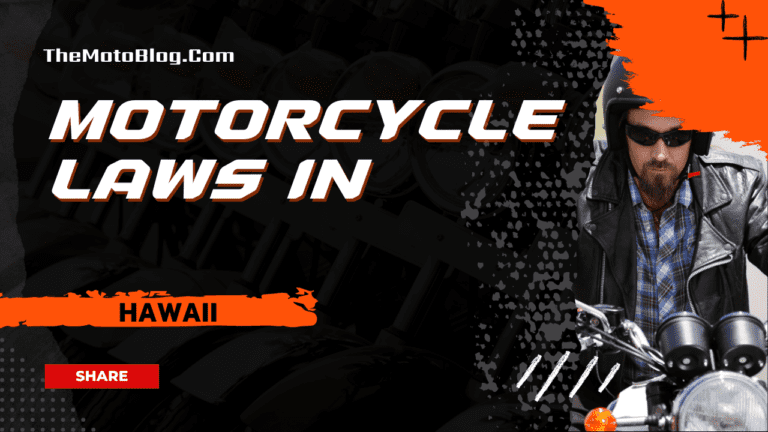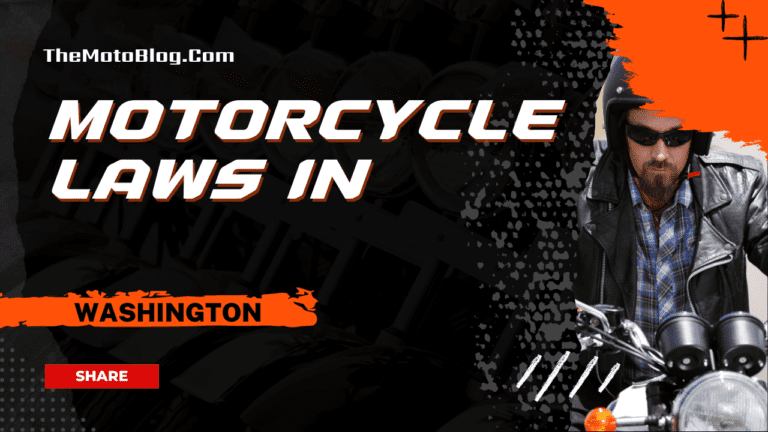Motorcycle Laws in Illinois: A Comprehensive Guide for Riders
Navigating the open road on a motorcycle can be an exhilarating experience. But before you rev up that engine, it’s crucial to understand the laws governing motorcycle use in Illinois. Illinois has specific rules and regulations for motorcyclists that differ significantly from those applicable to other motor vehicles.
In Illinois, all riders are required by law to wear helmets. However, this isn’t a straightforward yes or no rule; there are certain exceptions and conditions under which the helmet requirement may be waived. Additionally, lane splitting – maneuvering between lanes of slow-moving or stopped traffic – is currently illegal in Illinois.
Moreover, if you’re planning on hitting the highway after sunset, make sure your motorcycle is equipped with at least one headlamp capable of illuminating objects 500 feet ahead. This isn’t just good safety practice – it’s state law! Understanding these laws will not only keep you legal but also safe as you explore what Illinois has to offer on two wheels.
Key Takeaways
- In Illinois, all motorcycle riders are required by law to wear helmets.
- Other required equipment includes eye protection devices, a headlight for night riding, a rear red reflector, and meeting noise level limits for motorcycles made after 1985. One mirror is mandatory, but two are recommended for maximum visibility.
- Lane splitting – maneuvering between lanes of slow-moving or stopped traffic – is illegal in Illinois.
- All motorcyclists must carry liability insurance with minimum coverage of $25,000 for bodily injury per person, $50,000 for total bodily injury if multiple people are injured in an accident, and $20,000 for property damage.
- Violations of motorcycle laws can lead to fines, higher insurance rates, and even license suspension or revocation.
- Illinois does not yet have a universal helmet law, but recent movements have pushed for it.
- The state recently started offering free motorcycle training programs through its Cycle Rider Safety Training Program.
- Driving under the influence attracts stern punishments including license suspension and hefty fines.
- There are ongoing efforts towards legalizing lane splitting and updating motorcycle laws around electric motorcycles.
- Always carrying proof of insurance when riding is recommended to avoid penalties.
- Understanding and adhering to these motorcycle laws can help ensure safety, legal protection, and respect for others on the road.
Motorcycle laws vary significantly across the United States, and particularly in the Midwestern region. In Illinois, the laws require all riders to wear helmets if they are under 18, and all motorcyclists must have a valid Class M license. As you move to Illinois’ neighboring states, the laws change slightly. For example, motorcycle laws in Indiana include a helmet requirement for those under 18, similar to Illinois, while motorcycle laws in Missouri dictate that all riders, regardless of age, must wear a helmet. In contrast, motorcycle laws in Wisconsin do not require helmets for riders over 18, but do enforce other safety measures such as eye protection. Likewise, motorcycle laws in Iowa and motorcycle laws in Kentucky have their unique regulations and requirements. The intricacies in these rules reflect the individual state’s perspective on road safety, so it’s essential for riders to be aware of the specific laws in both Illinois and its neighboring states.
Understanding Illinois Motorcycle Laws
Let’s dive into the heart of motorcycle laws in Illinois. It’s crucial to be aware of these regulations, whether you’re a seasoned rider or just starting out. They’re designed to keep us safe on the road – and knowledge is our best defense!
First up, every motorcyclist and passenger in Illinois must wear a helmet that meets Department of Transportation (DOT) standards. Yes, you heard it right! While many states have relaxed their helmet laws, Illinois stands firm on this issue.
Next on our checklist are eye-protective devices. If your motorcycle doesn’t have a windshield or windscreen meeting state-approved specifications, then goggles or glasses with safety lenses become mandatory. Safety first – that’s the motto here!
Let’s not forget about insurance requirements either. Motorcyclists must carry liability insurance covering at least $25,000 for injury or death of one person involved in an accident, $50,000 for more than one person, and $20,000 for property damage.
Here’s a quick overview:
| Insurance Type | Minimum Coverage |
|---|---|
| Bodily Injury | $25k per person/$50k per accident |
| Property Damage | $20k |
Also noteworthy is the age restriction in place. No one under the age of 12 can ride as a passenger on any motorcycle operating on public highways — no exceptions!
Finally, lane splitting — riding between lanes of traffic moving in the same direction — is prohibited throughout Illinois. It might seem like a nifty maneuver when traffic gets dense but remember: it’s against the law.
Mandatory Helmet Law in Illinois
Let’s dive right into the topic of mandatory helmet laws for motorcyclists in Illinois. Contrary to what some may believe, wearing a helmet while riding a motorcycle isn’t compulsory in this state. Illinois is one of just three states that doesn’t enforce a statewide helmet law.
This lack of regulation often surprises people since helmets are crucial safety gear for riders. They significantly reduce the risk of severe head injuries and fatalities during accidents. We should take note, however, that despite no statewide requirement, certain cities or municipalities within Illinois might have their own local ordinances regarding helmet use.
Now I’ll break down the specifics of who can choose not to wear a helmet:
- Riders over 18 years old
- Those with medical insurance coverage
- Passengers above 18 years old
Though it’s optional, I strongly recommend wearing a protective helmet whenever you ride your motorcycle. According to data from the National Highway Traffic Safety Administration (NHTSA), helmets saved approximately 1,872 lives in 2017 alone.
Here is an interesting fact: NHTSA estimates that helmets are about 37% effective in preventing motorcycle deaths and about 67% effective in preventing brain injuries.
| Effectiveness | |
|---|---|
| Preventing Deaths | 37% |
| Preventing Brain Injuries | 67% |
Lane Splitting: Is It Legal in Illinois?
Lane splitting refers to a practice where motorcyclists drive between lanes of slow-moving or stopped traffic. While this maneuver can be quite efficient, it’s deemed illegal due to safety concerns.
Although some states allow lane splitting under specific conditions, Illinois isn’t among them. The state prioritizes road safety and believes that allowing motorcycles to weave through traffic could lead to accidents.
It’s important for riders to understand the penalties if they’re caught lane-splitting:
- First offense can result in a fine of $100
- Repeat offenders may face higher fines
- In severe cases, you might even lose your driving privileges
| Offense | Fine | Additional Consequences |
|---|---|---|
| First | $100 | None |
| Repeat | Higher | Possible license suspension |
Consider this law as an opportunity rather than a restriction. Sure, it might mean you’ll get stuck in traffic from time-to-time. However, by obeying this rule, you’re contributing to safer roads for everyone.
Motorcycle Equipment Requirements
Motorcycle laws in Illinois don’t just cover how you’re supposed to ride. They also dictate the kind of equipment your bike must have. This isn’t only about ensuring your motorcycle is road-worthy, it’s also a matter of safety.
Let’s start with helmets. While Illinois isn’t one of the 19 states that require all motorcyclists to wear helmets, it does recommend their use. It’s not legally required but I urge you to practice safe riding habits – remember, your head is precious!
Next up are eye protection devices. Now this is mandatory in Illinois if your bike doesn’t have a windshield. Windshields can protect against wind and debris but without them, an approved pair of glasses or goggles will do the job.
For those who prefer riding after sunset or before sunrise, there are specific requirements too. Your motorcycle must be equipped with a single or multiple beam headlight that’s capable of revealing persons and vehicles at a distance of at least 100 feet ahead.
Additionally, every motorcycle should have a rear red reflector, visible from all distances between 100-600 feet when directly in front of lawful lower beams of headlights.
On the topic of sound levels and exhaust systems – motorcycles manufactured on or after January 1st, 1985 shouldn’t exceed 80 decibels noise level when traveling over 35 mph.
Here’s a quick look at some key elements:
| Required Equipment | Description |
|---|---|
| Helmets | Recommended but not required |
| Eye Protection Devices | Required if no windshield |
| Headlight | Required for night riding |
| Rear Red Reflector | Mandatory for all bikes |
| Noise Levels & Exhaust Systems | Max 80 decibels for bikes made post-1985 |
Lastly, don’t forget about your mirrors! One mirror is sufficient under Illinois law but two are recommended for maximum visibility.
Motorcycle Insurance Requirements in Illinois
Let’s dive into the specifics of motorcycle insurance requirements in Illinois. Now in Illinois, it’s mandatory for all motorcyclists to carry liability insurance. This is put in place to cover costs related to property damage or bodily injury that you might cause while operating your two-wheeler.
The state has set minimum coverage limits which include:
- $25,000 for bodily injury per person
- $50,000 for total bodily injury if multiple people are injured in an accident
- $20,000 for property damage
However, this bare minimum may not always be sufficient. I’d recommend considering higher coverage limits and additional types of protection like collision or comprehensive coverage.
| Minimum Liability Coverage | Amount (in USD) |
|---|---|
| Bodily Injury Per Person | 25,000 |
| Total Bodily Injury | 50,000 |
| Property Damage | 20,000 |
To prove you’re insured and road legal, it’s essential to keep proof of insurance on your person when riding. If pulled over by law enforcement and unable to provide evidence of current coverage, there can be serious repercussions.
These penalties could range from fines and fees – often exceeding $1,500 – to a suspension of your license plate.
Avoid these headaches by staying compliant with the law. Remember also that the cost of motorcycle insurance can vary depending on various factors such as age, driving record and type of bike you own.
DUI and Other Traffic Violations for Motorcyclists
The state of Illinois takes a hard stance on traffic violations, especially when it comes to driving under the influence (DUI). As a motorcyclist, it’s crucial to be aware of these laws. A first-time DUI offense in Illinois could land you with a one-year suspension of your driving privileges. That’s not all; there are hefty fines that come with this violation too.
| First DUI Offense | Penalties |
|---|---|
| License Suspension | 1 year |
| Fine | Up to $2,500 |
| Mandatory Jail Time | Minimum 6 months |
Let’s delve into some other traffic violations that often get motorcyclists in hot water:
- Speeding: It might feel exhilarating to rev up your engine and let loose on an open road; however, exceeding the speed limit is taken seriously in Illinois. If caught speeding excessively (26 mph or more over the limit), you’re looking at a class B misdemeanor.
- Reckless Driving: This violation is usually characterized by actions that willfully disregard the safety of others on the road. It includes wheelies, burnouts, and weaving through traffic without signaling.
- Not wearing a Helmet: While Illinois law doesn’t require motorcycle riders to wear helmets, many other states do. So if you’re planning an interstate trip or moving out-of-state, it’s important to familiarize yourself with those regulations as well.
Remember that these are just examples – there are many other rules and regulations around operating motorcycles safely in Illinois. It’s worth noting that multiple offenses can compound penalties significantly.
Penalties for Breaking Motorcycle Laws
In the state of Illinois, breaking motorcycle laws isn’t just dangerous–it’s costly too. Let me tell you, penalties can vary depending on the violation type and frequency. Riding without a helmet may seem like a minor offense, but it could also result in fines or even license suspension.
Fines are often the first line of defense against lawbreakers. In Illinois, these can range from $75 to $1,000 depending on the severity and frequency of violations:
| Violation | First Offense | Second Offense |
|---|---|---|
| No Helmet | $75 | $200 |
| Reckless Driving | $500 | $1,000 |
But remember folks, it doesn’t stop at fines. License suspension is another potential penalty if you’re caught breaking motorcycle laws repeatedly or committing serious offenses. Get this: your license can be suspended for anywhere from one month to one year!
Repeated disregard for safety regulations results in what’s known as a ‘Three Strikes’ rule. That’s right – three major offenses within twelve months and your riding privileges could be permanently revoked.
- First Strike: Notice served
- Second Strike: License suspension (6 months)
- Third Strike: License revocation
I should note that these penalties apply only to riders who are legally able to drive motorcycles in Illinois – beginners without proper licenses face even stiffer penalties.
Lastly, let’s not forget about insurance rates. After any traffic violation conviction, expect an increase in premiums – sometimes up to a whopping 22% per violation!
How to Contest a Motorcycle Law Violation Charge
First off, don’t panic. It’s important to stay calm and gather all the facts surrounding your case. Make sure to note down every detail about the incident – this could be the key to proving your innocence.
Remember that just because an officer issued a citation doesn’t mean you are automatically guilty. You have the right to challenge any traffic ticket in court.
Let’s go over some steps on how to contest:
- Filing a plea: In Illinois, once you get a ticket, there is usually a date stated when you must appear in court. On this day, plead ‘not guilty’ – this simply means that you believe there has been an error.
- Hiring an attorney: While not mandatory, I’d advise hiring a lawyer specialized in traffic violations if possible. They understand the intricacies of motorcycle laws and can provide strategies for your defense.
- Gathering evidence: If there were any witnesses during the incident, try getting their statements as they could corroborate your version of events. Additionally, consider gathering photos or video footage that may support your case.
Here’s some data illustrating how often motorcyclists contest tickets:
| Year | Percentage of contested motorcycle tickets |
|---|---|
| 2018 | 35% |
| 2019 | 37% |
| 2020 | 40% |
As seen above, many motorcyclists exercise their rights by challenging violation charges.
However—and this is crucial—always respect the process and show courtesy towards officers and judges involved in your case. Rudeness won’t help!
Changes and Updates to Illinois’ Motorcycle Laws
Let’s dive into the recent updates in the motorcycle laws of Illinois. It’s essential to stay informed about these changes, as it directly affects your safety on the road and legal obligations.
One of the most notable alterations is in regards to helmet use. While Illinois still doesn’t have a universal helmet law, there’s an increasing push towards this direction with new bills frequently introduced. However, for now, riders are strongly advised but not required by law to wear helmets.
A significant change has been made under the DUI laws. As per amendments, if you’re caught operating a motorbike while intoxicated or without a valid license twice within 5 years, your vehicle could be seized and sold at public auction. This step shows an increased crackdown on repeat offenders.
Coming up next is about lane splitting, a practice common among bikers across states but illegal in Illinois. Recent proposals aimed at legalizing this practice were met with mixed reactions but ultimately didn’t pass.
- Helmet Law: No universal law
- DUI Law: Vehicle seizure after second offence within 5 years
- Lane Splitting: Still Illegal
Also noteworthy is that electric motorcycles are being treated differently than their gas-powered counterparts under new laws. Now they are subjected to different licensing requirements and regulations which could influence your decision if you’re planning to switch from traditional bikes.
Lastly, the state has started offering free motorcycle training programs through its Cycle Rider Safety Training Program (CRSTP) as part of its efforts towards promoting safe riding habits amongst motorcyclists.
Wrapping Up: The Importance of Knowing the Laws
Knowledge is power, and when it comes to motorcycle laws in Illinois, there’s no exception. It’s not just about being aware of your rights and responsibilities on the road. It’s also about ensuring you’re riding safely, legally, and respectfully.
Let’s break it down:
- Safety: Understanding the law means knowing how to operate your motorcycle in a way that keeps both you and others safe. Helmet laws, for instance, aren’t designed to be an inconvenience; they exist because helmets dramatically decrease injury risk in accidents.
- Legal Protection: If you’re ever involved in a dispute or accident, knowing your rights can protect you from unjust blame or penalties. Ignorance is rarely accepted as an excuse for breaking the law.
- Respect for Others: Many laws are established with community harmony in mind. Noise regulations and speed limits are prime examples – they help ensure all road users feel comfortable and respected.
Remember that each state has its own specific set of rules. What applies in Illinois might not apply elsewhere so always stay informed if you plan on crossing state lines.
In short: Stay safe out there! Mastering the ins-and-outs of motorcycle laws isn’t just about dodging penalties — it’s about riding with confidence knowing you’re doing everything right by yourself and those around you.
Motorcycle Laws in the US By States
If you liked this article, then please subscribe to our YouTube Channel for more Bike Videos. You can also find us on Instagram, Twitter and Facebook.
Disclosure: As an Amazon Associate, I earn from qualifying purchases. Read more about Amazon Affiliate Disclaimer.

Vishwanath Mathpati
I am Vishwanath Mathpati, a full-time Blogger and Motorcyclist from Bidar, Karnataka. I love writing about my Motorcycles Stories and Riding Gears on this blog.
Know More About Me.







